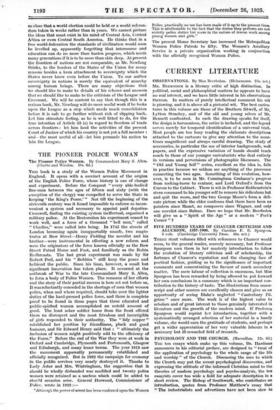THE PIONEER POLICE WOMAN The Pioneer Police Woman. By Commandant
Mary S. Allen. (Chatto and Windus. 10s. 6d.) Trim book is a study of the Women Police Movement in England. It opens with a succinct account of the origins of the English Police Force, whose history is one of change and experiment. Before the Conquest " every able-bodied free-man between the ages of fifteen and sixty (with the exception of the clergy) was compelled to serve the State in keeping the King's Peace. " Not till the beginning of the sixteenth century was it found impossible to enforce so incon- venient a system and necessary to appoint paid deputies. Cromwell, finding the existing system ineffectual, organized a military police. At the Restoration his experiment-ceased to work well, and a force of a thousand " bell men," called " Charles," were called into being. In 1745 the streets of London becoming again insupportably unsafe, two magis- trates at Bow Street—Henry Fielding the novelist and his brother—were instrumental in effecting a new reform and were the originators of the force known officially as the Bow Street Patrol Horse and Foot, and familiarly as the Robin Redbreasts. The last great experiment was made by Sir Robert Peel, and his " Bobbies " still keep the peace and befriend the public. Since his time, however, a small but significant innovation has taken place. It occurred at the outbreak of War to the late Commandant Mary S. Allen, to form a body of Police Women. The romance of her efforts and the story of their partial success is here set out before us. It was reluctantly conceded in the shortage of men that women police, when and where required, should take over the lighter duties of the hard-pressed police force, and there is complete proof to be found in these pages that these educated and public-spirited women accomplished an untold amount of good. The least sober soldier home from the front offered them no disrespect and the most frivolous and incorrigible of girls responded to their authority. The " lidy copper" established her position by friendliness, pluck and good humour, and Sir Edward Henry said that : " ultimately the inclusion of women might positively add to the efficiency of the Force." Before the end of the War they were at work in Oxford and Cambridge, Plymouth and Portsmouth, Glasgow and Edinburgh, and many lesser towns. The year 1919 saw the movement apparently permanently established and officially recognized. But in 1922 the campaign for economy in the public services very nearly destroyed it. Thanks to Lady Astor and Mrs. Wintringham, the suggestion that it should be wholly disbanded was modified and twenty police women were retained as a nucleus which could be added to should occasion arise. General Horwood, Commissioner of Police, wrote in 1923 :—
"Although the power of arrest has been conferred upon the Women
Police, practically no use has been made of it up to the present time. This is attributable to the fact that the duties they -perform are not strictly police duties but more in the nature of rescue work among young women and girls."
The present Home Secretary has increased the Metropolitan Women Police Patrols to fifty. The Women's Auxiliary Service is a private organization working in conjunction with the officially recognized Women Police.






































 Previous page
Previous page